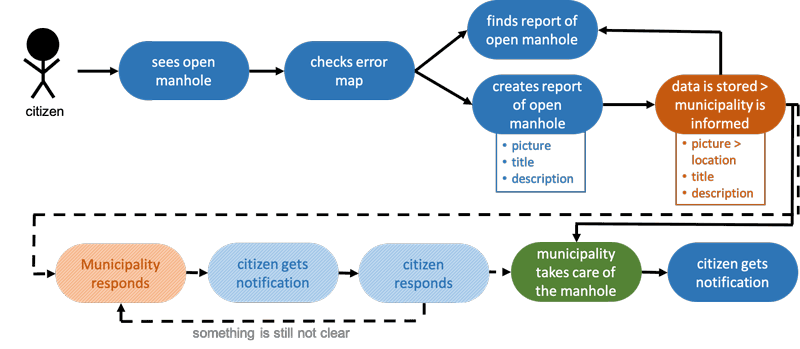by Jennifer Wolfgeher (FH Burgenland), Mario Zsilak (Forschung Burgenland) and Markus Tauber (FH Burgenland)
Digitalisation is already supporting individuals and smart cities in various ways. To increase automatization and digitisation, decisions must be based on trustworthy information. We are investigating the most common features of citizen participation and smart city platforms with the aim of determining the trustworthiness of the digital environment in this context.
Increased digitisation and automatization require applications that make it easy for citizens to report errors and be informed about possible incidents in their municipality. Such an incident management system can be citizen-based or automated via IoT (Internet of Things). An interaction between a citizen and the local authority may be to report an incident, e.g., an open manhole. An automated (IoT supported) version of this interaction would be the collection of relevant data from sensors. In any case, as actions are being triggered, both the citizen and the local authority needs information to be trustworthy.
Hence, on the municipality side, reliable and trustworthy data is essential, just as it is vital for citizens to know that they can rely on information they receive - such as disaster warnings. Trust is the most important requirement in emergency situations, in particular, but also in less extreme events like roadworks or construction areas. Existing smart city applications and citizen participation platforms provide features relevant for such scenarios.
In the literature many platforms and applications have been investigated [1],[2] on the basis of their features and potential to enhance sustainability, but the need for security and trustworthiness is rarely addressed. This is reflected in real-life citizen participation and smart city platforms (e.g. platforms from Austria and Luxemburg, smart city projects from Stockholm and Singapore [L1-L4]). In these smart cities, the applications designed to increase citizen participation and make residents lives easier, rarely guarantee the reliability of exchanged information. Whilst including a number of useful features (like interactive maps, online participation in political discussions, waste service information and smart parking), no existing system provides incident management as an application in a trustworthy IoT environment. To enable reliable incident reports from citizens, information must be communicated to the municipality in a trustworthy manner, allowing the local authority to take action in dangerous situations (e.g. open manholes). On the citizen’s side, only approved information about actual conditions from the municipality or sensors must be received, in order to ensure people’s safety. Thus, a trustworthy framework to enable secure communication and to link individual services from existing heterogeneous platforms is required.
The Arrowhead framework [L5] is one example of a secure IoT framework that can integrate smartphones, sensors and external services in a smart city context. Sensors are already involved in the Arrowhead framework in different contexts, including industrial IoT (IIoT) and smart homes [L5]. This open-source framework provides many security functions by design, with the objective to facilitate security, reliability, real-time communication and safety in local cloud automation. With the chain of trust principle, it enables the usage of all services of the Arrowhead local cloud and the services of other clouds that are compliant with the Arrowhead framework, based on a secure on-boarding procedure.
In addition to the security advantages, Arrowhead supports a multi-cloud solution that would make it possible to stick together the “patchwork” of applications for smart city and citizen participation projects, e.g. the many applications of the smart nation of Singapore [L4] could be accessed via one service. The citizen could find the waste service as well as the parking service or tax service in one place. The applications could be in one cloud or distributed in separate, Arrowhead compliant, clouds, but the chain of trust would still be available from the citizen to each service.
The Arrowhead framework provides a chain of trust via various mechanisms, including certificates and secure on-boarding [3] to enable a trustworthy environment. Arrowhead is a fitting framework for the deployment of an incident report service in a trustworthy environment, capable of meeting the objectives of security, reliability, real-time communication and safety.

Figure 1: Use case - incident report.
Further research, in the EFRE project “civis 4.0 patria” (FE07) will include the actual deployment of an incident management feature considering frameworks like Arrowhead to support the development of smart municipalities.
Links:
[L1] https://www.buergermeldungen.com
[L2] https://kwz.me/hEN
[L3] https://kwz.me/hEe
[L4] https://www.smartnation.sg
[L5] https://www.arrowhead.eu/
References:
[1] O. Gil, M. E. Cortes-Cediel, I. Cantador: “Citizen participation and the rise of digital media platforms in smart governance and smart cities”, Int. Journal of E-Planning Research (IJEPR), 8(1), 19–34, 2019.
[2] A. M. Pozdniakova, et al.: “Smart sustainable cities: The concept and approaches to measurement”, Acta Innovations, (22), 5–19, 2017.
[3] A. Bicaku, et al.: “Interacting with the arrowhead local cloud: On-boarding procedure”, in 2018 IEEE Industrial Cyber-Physical Systems (ICPS), pp. 743-748. IEEE, 2018.
Please contact:
Jennifer Wolfgeher
FH Burgenland, Austria











